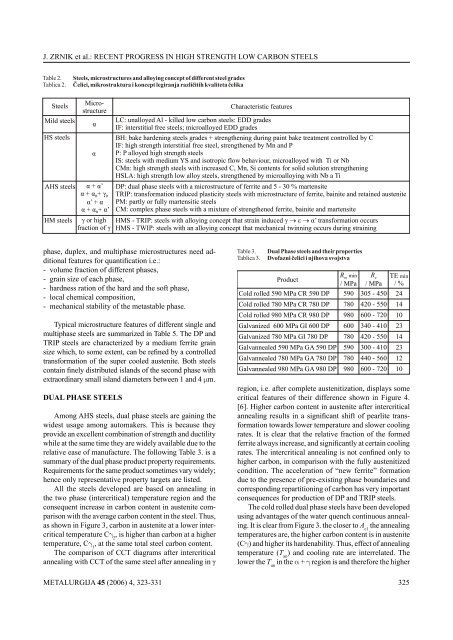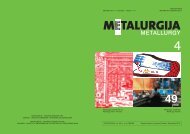pdf - 14652 kB - CARNet
pdf - 14652 kB - CARNet
pdf - 14652 kB - CARNet
Create successful ePaper yourself
Turn your PDF publications into a flip-book with our unique Google optimized e-Paper software.
J. ZRnIk et al.: REcEnT pRoGREss In hIGh sTREnGTh Low cARbon sTEELs<br />
phase, duplex, and multiphase microstructures need additional<br />
features for quantification i.e.:<br />
- volume fraction of different phases,<br />
- grain size of each phase,<br />
- hardness ration of the hard and the soft phase,<br />
- local chemical composition,<br />
- mechanical stability of the metastable phase.<br />
typical microstructure features of different single and<br />
multiphase steels are summarized in Table 5. The Dp and<br />
trIP steels are characterized by a medium ferrite grain<br />
size which, to some extent, can be refined by a controlled<br />
transformation of the super cooled austenite. both steels<br />
contain finely distributed islands of the second phase with<br />
extraordinary small island diameters between 1 and 4 mm.<br />
Dual phase steels<br />
Among Ahs steels, dual phase steels are gaining the<br />
widest usage among automakers. this is because they<br />
provide an excellent combination of strength and ductility<br />
while at the same time they are widely available due to the<br />
relative ease of manufacture. The following Table 3. is a<br />
summary of the dual phase product property requirements.<br />
requirements for the same product sometimes vary widely;<br />
hence only representative property targets are listed.<br />
All the steels developed are based on annealing in<br />
the two phase (intercritical) temperature region and the<br />
consequent increase in carbon content in austenite comparison<br />
with the average carbon content in the steel. Thus,<br />
as shown in Figure 3, carbon in austenite at a lower intercritical<br />
temperature cg 2 , is higher than carbon at a higher<br />
temperature, cg 1 , at the same total steel carbon content.<br />
The comparison of ccT diagrams after intercritical<br />
annealing with CCt of the same steel after annealing in γ<br />
region, i.e. after complete austenitization, displays some<br />
critical features of their difference shown in Figure 4.<br />
[6]. higher carbon content in austenite after intercritical<br />
annealing results in a significant shift of pearlite transformation<br />
towards lower temperature and slower cooling<br />
rates. It is clear that the relative fraction of the formed<br />
ferrite always increase, and significantly at certain cooling<br />
rates. the intercritical annealing is not confined only to<br />
higher carbon, in comparison with the fully austenitized<br />
condition. The acceleration of “new ferrite” formation<br />
due to the presence of pre-existing phase boundaries and<br />
corresponding repartitioning of carbon has very important<br />
consequences for production of Dp and TRIp steels.<br />
The cold rolled dual phase steels have been developed<br />
using advantages of the water quench continuous annealing.<br />
It is clear from Figure 3. the closer to A c1 the annealing<br />
temperatures are, the higher carbon content is in austenite<br />
(cg) and higher its hardenability. thus, effect of annealing<br />
temperature (T an ) and cooling rate are interrelated. The<br />
lower the T an in the a + g region is and therefore the higher<br />
METALURGIJA 45 (2006) 4, 323-331 325
















